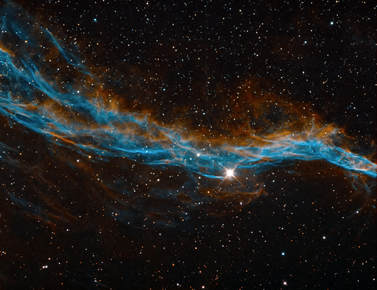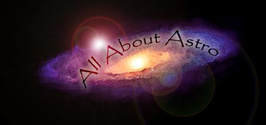
This is an image of NGC 6960, the western portion of the Veil Nebula. Known as the "Witch's Broom" or "Finger of God," among other names, this is only a small part of a larger complex of a supernova remnant; an exploded star. This intricate display of hydrogen and oxygen gases is centered around the star 52 Cygni, not the star that originally "blew up."
I found the data for this image on our server in the Conley Observatory of the Three Rivers Foundation. Taken this past June 2018 with some students at our week-long "Astrophysics in a Nutshell" course, there was only 2 hours of data total, 1 hour each of ionized hydrogen and oxygen data.
Honestly, I didn't think much of the data, since we are now so conditioned to going LONG with our images. So, instead of thinking of a good image, I merely passed it off as a part of the learning with our students. Certainly, more exposure time could bring out more of the faint background gases and clean up the image a little better, but processing it like this just goes to show that not everything NEEDS hours of exposure time.
This is a bicolor image, using hydrogen (H-alpha) data mapped to the red channel of a traditional RGB image. Oxygen (OIII) data is mapped to the blue channel and a 70/30 percent blend of OIII and H-alpha respectively are assigned to the green channel of the image.
Taken onsite at Comanche Springs Astronomy Campus. Shot through a 12.5" RCOS RC and FLI PL-16803 camera atop a Paramount ME. Filters used are AstroDon 3nm spectral band filters.
Hope you enjoy it!
I found the data for this image on our server in the Conley Observatory of the Three Rivers Foundation. Taken this past June 2018 with some students at our week-long "Astrophysics in a Nutshell" course, there was only 2 hours of data total, 1 hour each of ionized hydrogen and oxygen data.
Honestly, I didn't think much of the data, since we are now so conditioned to going LONG with our images. So, instead of thinking of a good image, I merely passed it off as a part of the learning with our students. Certainly, more exposure time could bring out more of the faint background gases and clean up the image a little better, but processing it like this just goes to show that not everything NEEDS hours of exposure time.
This is a bicolor image, using hydrogen (H-alpha) data mapped to the red channel of a traditional RGB image. Oxygen (OIII) data is mapped to the blue channel and a 70/30 percent blend of OIII and H-alpha respectively are assigned to the green channel of the image.
Taken onsite at Comanche Springs Astronomy Campus. Shot through a 12.5" RCOS RC and FLI PL-16803 camera atop a Paramount ME. Filters used are AstroDon 3nm spectral band filters.
Hope you enjoy it!
 RSS Feed
RSS Feed
